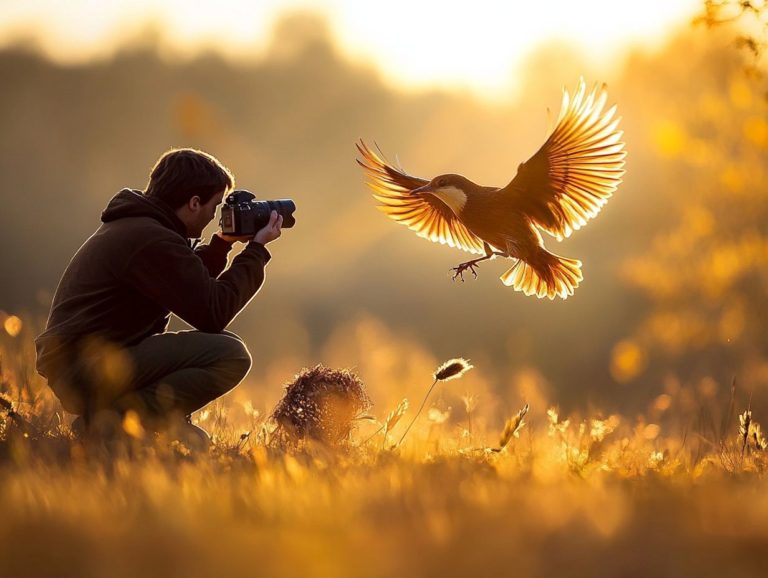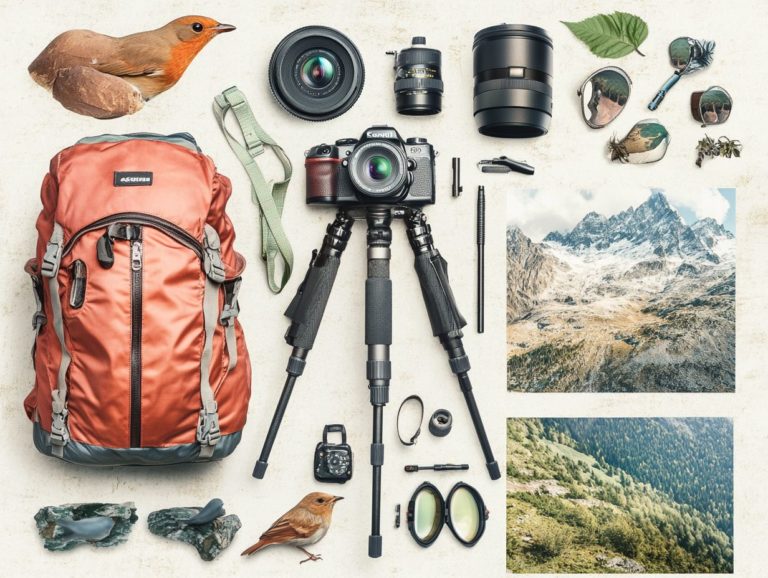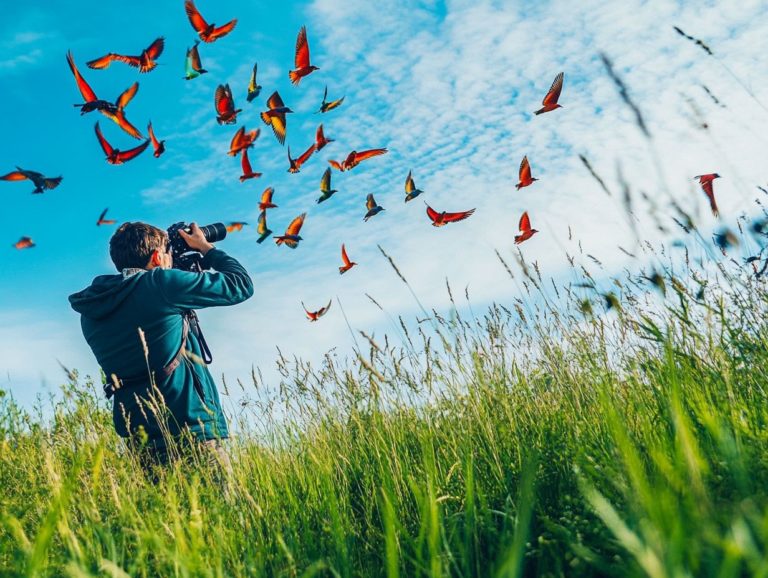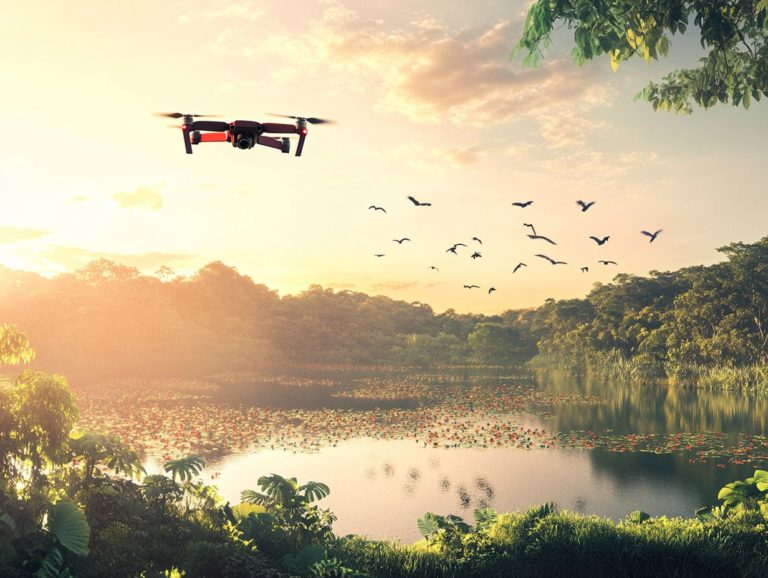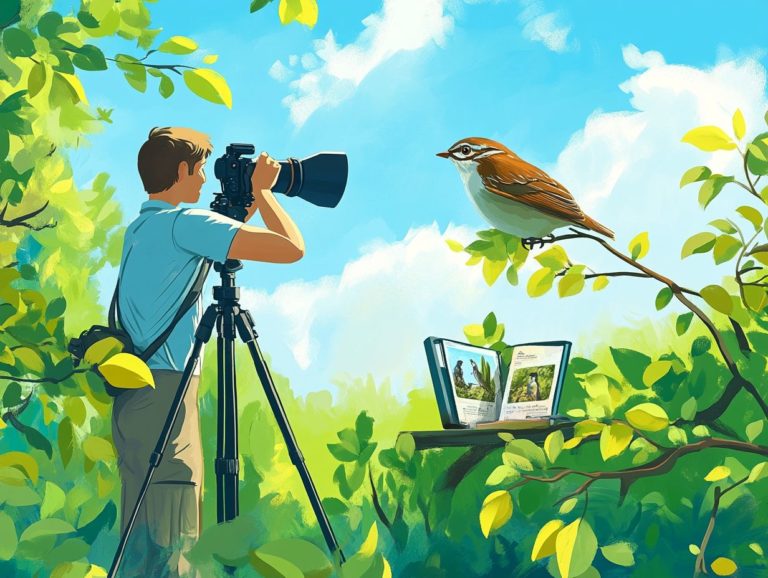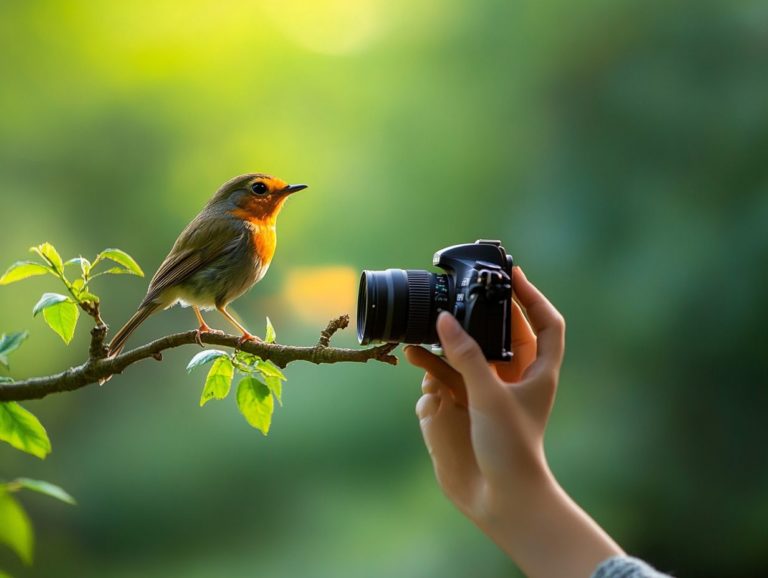How to Photograph Birds with Different Backgrounds
Bird photography is a mesmerizing fusion of art and science, giving you the opportunity to capture the grace and behavior of our avian companions in their natural settings.
This guide delves into the distinctive elements of bird photography, covering everything from choosing the ideal equipment and settings to perfecting techniques tailored for different backgrounds.
You’ll uncover valuable insights on composition, learn how to tackle common challenges, and discover ways to maximize your shooting environment.
Whether you re just starting out or seeking to hone your skills, this guide will take your bird photography to the next level!
Contents
- Key Takeaways:
- Understanding Bird Photography
- Equipment and Settings for Bird Photography
- Techniques for Photographing Birds with Different Backgrounds
- Composition Tips for Bird Photography
- Troubleshooting Common Challenges
- Frequently Asked Questions
- What are some tips for photographing birds in various settings?
- How can I use different settings to make my bird photos more interesting?
- What camera settings should I use when photographing birds in various settings?
- Is lighting important when photographing birds in various settings?
- How can I incorporate the natural habitat into my bird photos?
- What are some compositional tips for photographing birds in various settings?
Key Takeaways:
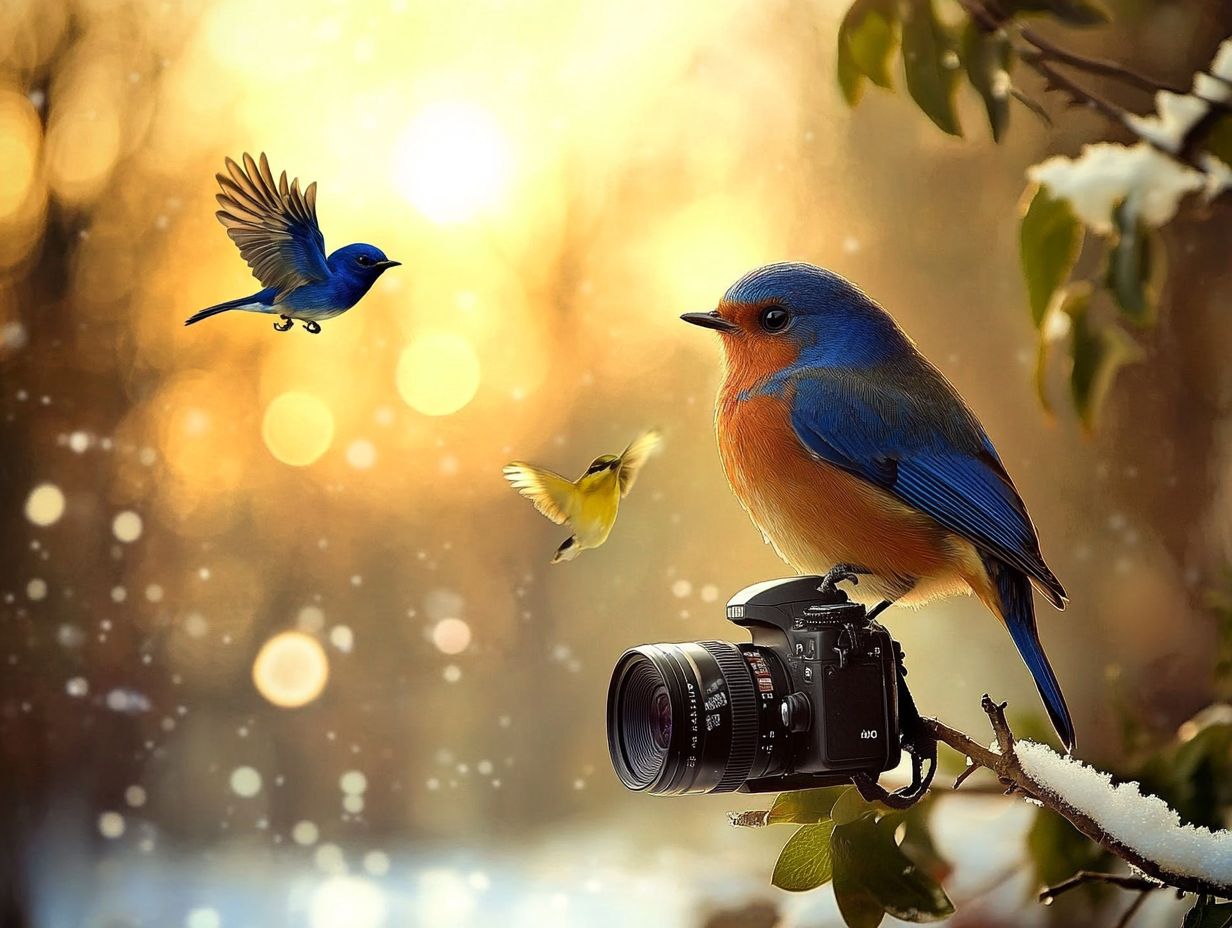
- Choose the right equipment and settings for stunning bird photos.
- Use techniques to capture birds in their natural environments.
- Apply composition rules for visually striking images.
Understanding Bird Photography
Bird photography is a captivating genre that invites you to capture the beauty and behavior of wild birds in their natural habitats. This specialized field merges an understanding of avian behavior, the nuances of photography, and a profound respect for wildlife.
As you explore various birding hotspots, you ll harness your skills to create stunning visuals while adhering to ethical practices. From the delicate flutter of a hummingbird to the majestic flight of an eagle, bird photography offers you the remarkable opportunity to showcase the enchanting world of birds.
What Makes Bird Photography Unique?
Bird photography stands out as a captivating blend of artistry and a profound understanding of wild birds and their natural behaviors. It s an opportunity to capture fleeting moments that weave a compelling narrative.
The true allure of this genre lies in the challenge of photographing elusive species, where every click of the shutter reflects your patience and skill. You may find yourself camouflaged, observing from a distance as birds engage in their intricate dances or flaunt their vibrant plumage.
Adopting ethical practices is essential; it fosters respect for these remarkable creatures and their habitats, enhancing your photographic journey.
Renowned wildlife photographers like Art Wolfe and Joel Sartore exemplify this delicate balance. They capture the joy of photographing birds mid-flight or during breathtaking displays while passionately advocating for bird conservation.
Equipment and Settings for Bird Photography
Choosing the right equipment and settings is essential for your success in bird photography. Here, precise camera settings, the right lens choices, and a solid grasp of various photography techniques are all critical components.
You ll often find that long lenses are your best friend; they allow you to photograph wild birds from a distance without interrupting their natural behavior. Incorporating advanced features like autofocus tracking can dramatically increase your chances of capturing sharp images of fast-moving subjects.
Camera and Lens Selection
Choosing the right camera and lens for bird photography can elevate your ability to capture stunning images. Whether you opt for a superzoom camera or a professional body like the Nikon Z8 or Canon RF, each choice can lead to remarkable results.
Many bird enthusiasts rave about the impressive capabilities of the Sony A1 and Olympus OM-D, especially for their outstanding autofocus and color accuracy. If you value convenience, superzoom cameras offer incredible versatility without the hassle of juggling multiple lenses.
Long lenses, like the 600mm or 800mm, grant you the reach needed to get close to distant subjects, making them perfect for wildlife photography. In contrast, superzoom cameras provide a lightweight, all-in-one solution, ideal for those who prefer to travel light or stay mobile.
When selecting your camera, mastering settings such as ISO (a measure of your camera’s sensitivity to light), aperture, and shutter speed is crucial for capturing crystal-clear, action-packed shots, regardless of your gear.
Now that you understand the essentials, grab your camera and head out to practice your bird photography!
Recommended Settings for Different Backgrounds
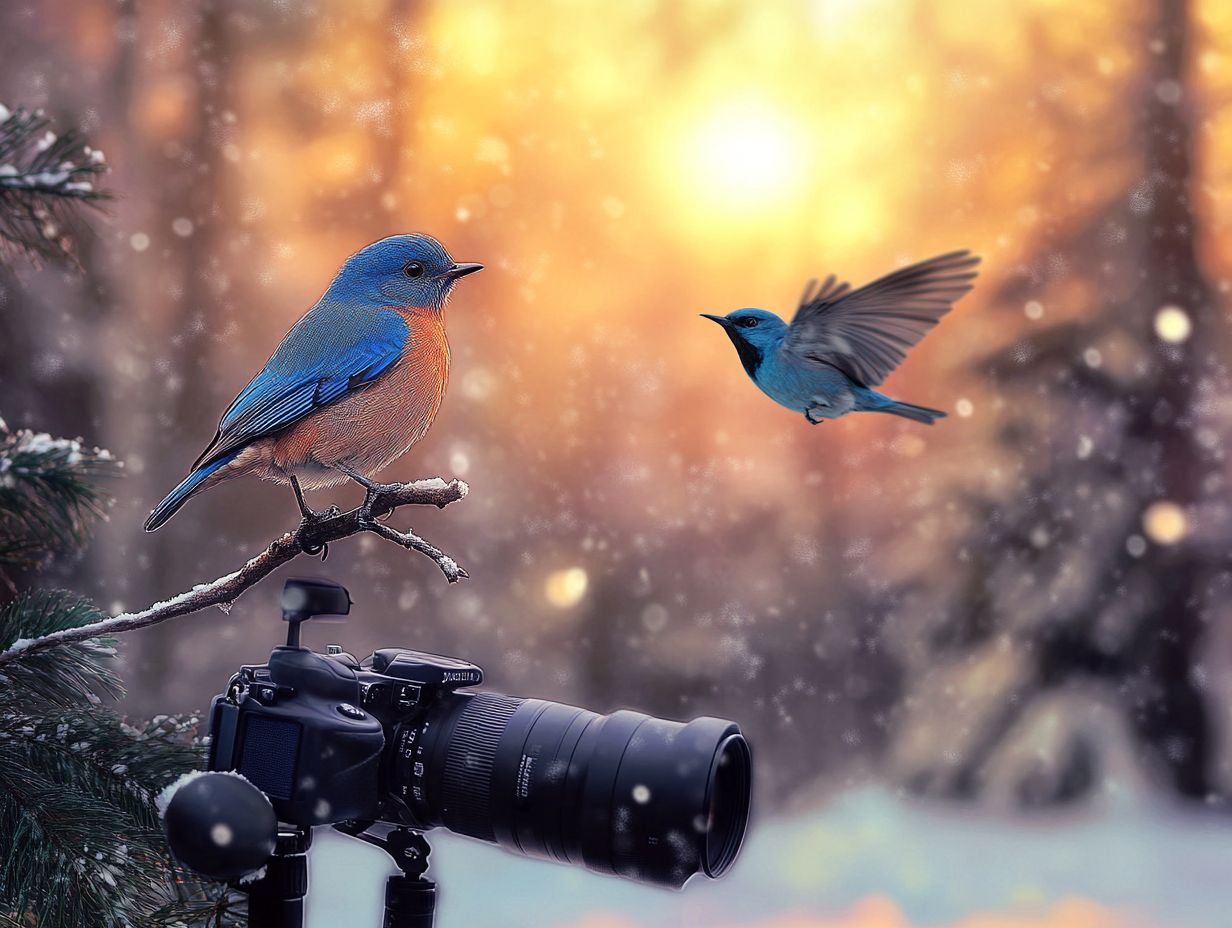
To capture breathtaking bird photographs, it’s important to understand the recommended camera settings for different backgrounds. Additionally, learning how to use natural framing in bird photography can help you adapt to changing light conditions and compositions.
By considering elements like shutter speed, aperture, and ISO, you can capture the beauty and intricate details of birds. Adjusting your shutter speed is vital for photographing fast-moving birds to eliminate motion blur.
The aperture setting controls the area in focus, helping your subject stand out against a beautifully blurred background. Don’t overlook the ISO setting; be mindful of ambient light and potential shadows in the environment.
Observing bird behavior offers valuable insights. Recognizing when a bird is about to take flight allows you to adjust your settings for perfect captures.
Techniques for Photographing Birds with Different Backgrounds
To master photographing birds against various backgrounds, engage in strategic planning and familiarize yourself with birding hotspots. Additionally, explore techniques for photographing birds in flight to utilize effective photography methods.
This thoughtful approach enables you to capture stunning images that showcase the beauty of your avian subjects.
Shooting in Natural Environments
Shooting in natural environments presents unique challenges and rewards for a bird photographer. It allows authentic captures of wild birds in their habitats.
To achieve stunning images, blend patience, skill, and an understanding of avian behavior. Invest time in learning about local birds and observe their routines.
Staying inconspicuous is crucial. Using camouflage clothing, staying quiet, and maintaining a respectful distance enhances your chances of capturing that perfect shot.
Identifying key birding hotspots, like wetlands, forests, or migratory routes, increases your success rates and provides opportunities to photograph diverse species while minimizing stress on wildlife.
Creating a Controlled Background
Creating a controlled background can enhance your bird photography, allowing you to isolate your subjects and minimize distractions. Additionally, learning how to use natural light in bird photography can further improve your images.
By strategically setting up backdrops or using natural elements like branches or leaves, you can craft a visually appealing experience. This technique frames your subject and draws the viewer’s attention to the bird, which is essential in understanding the basics of bird photography composition.
Embracing composition techniques, such as the rule of thirds, guides the viewer’s eye to the bird, amplifying the overall impact of your image. Selecting the right equipment is essential for achieving the desired depth of field.
Composition Tips for Bird Photography
Mastering effective composition is crucial for elevating your bird photography. Use techniques like the rule of thirds and leading lines to enhance the visual allure of your images.
These strategies guide the viewer’s eye and create a dynamic interplay between the subject and its surroundings, transforming a snapshot into a compelling work of art.
Utilizing the Rule of Thirds
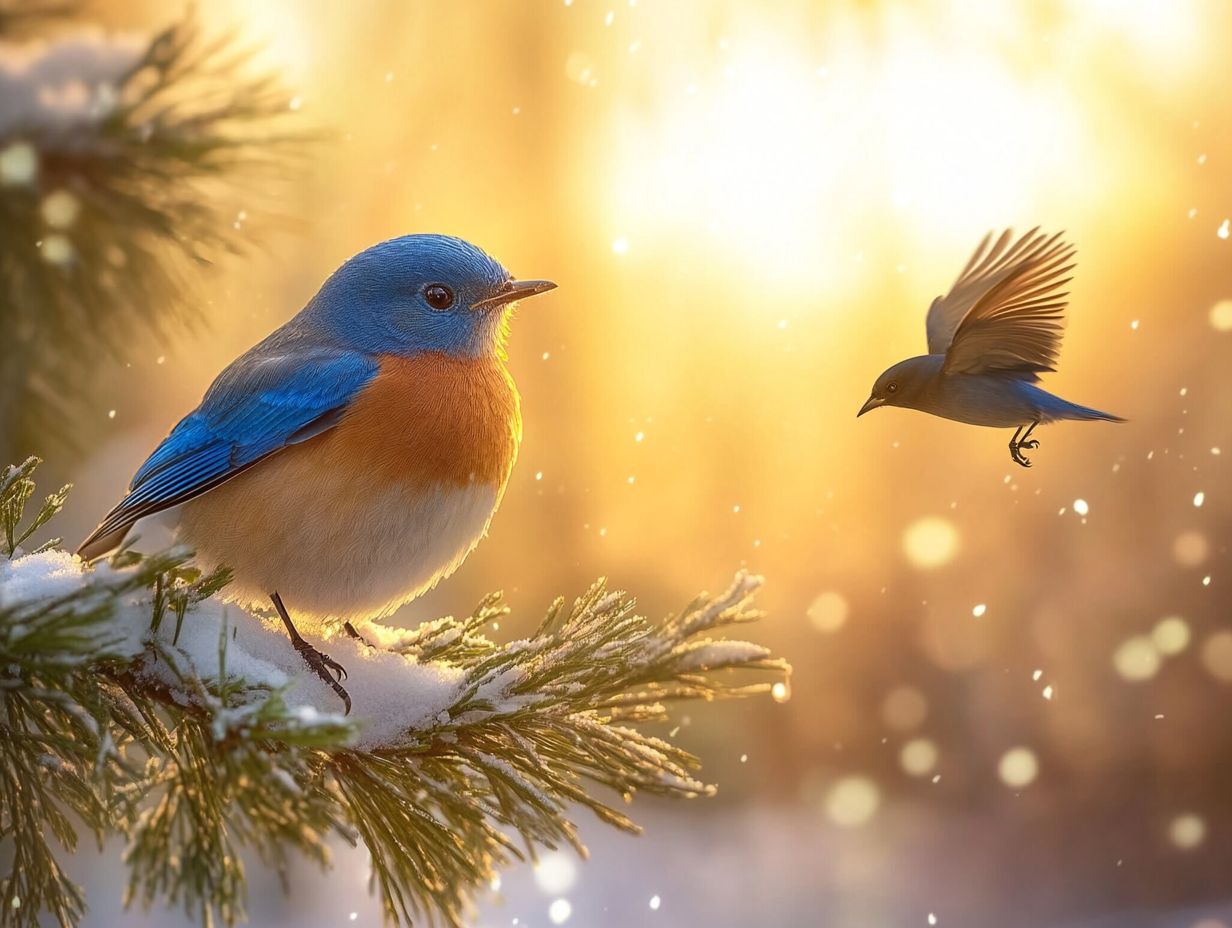
Utilizing the rule of thirds is one of the most effective composition techniques in bird photography. By positioning your subjects at the intersecting points, you create greater visual interest.
Strategically placing the bird along these lines draws the viewer’s eye to the subject and fosters a more dynamically engaging image that truly captures the essence of the scene. For instance, when photographing a soaring eagle, positioning it slightly off-center can highlight the vastness of the sky, allowing for a more immersive experience.
Experimenting with various backgrounds like contrasting lush greenery or open blue skies can enhance this effect, making each shot uniquely yours. Whether you’re capturing a bustling flock or a solitary bird, embracing the principles of composition to enhance bird photos while remaining open to improvisation can lead to stunning results that celebrate the beauty of nature.
Using Leading Lines
Incorporating leading lines in your bird photography elegantly guides the viewer’s eye toward your subject, creating a rich sense of depth and enhancing the overall composition.
These lines can manifest in various forms, from the graceful curves of a winding river to the crisp edges of a fence or even the delicate branches of a nearby tree. By positioning your camera strategically, you can leverage these elements to frame the bird seamlessly, drawing attention to it against the backdrop of its environment.
Consider capturing a heron poised at the edge of a serene lake. The image becomes far more striking when the shoreline’s lines lead the viewer’s gaze directly to the bird. Take a moment to observe the landscape for pathways, horizon lines, or the arrangement of vegetation. Such elements can dramatically enhance the impact of your image, transforming it from a mere snapshot into a captivating story waiting to unfold.
Troubleshooting Common Challenges
Navigating common challenges in bird photography, like managing harsh lighting or capturing fast-moving birds, demands a solid arsenal of tips. Knowing how to stay hidden while bird photography can enhance your ability to swiftly adapt your camera settings. This dual approach will elevate your skills and dramatically improve your shots!
Dealing with Harsh Lighting
Harsh lighting in bird photography can be quite the challenge. However, understanding effective camera settings and techniques will elevate your image quality.
One powerful strategy is adjusting your camera s light adjustment to reduce the risk of overexposing highlights, which often occurs in bright conditions. A polarizing filter can be a game-changer, enhancing color saturation and minimizing glare making it an essential tool in these situations.
Take advantage of the golden hours just after sunrise and just before sunset when the lighting is softer and warmer, perfect for capturing the vibrant hues of your feathered subjects. You can improve your image quality by positioning yourself in the shade or using natural obstacles to block direct sunlight, allowing for stunning captures without the harsh contrast that midday light typically brings.
Adjusting for Fast-Moving Birds
Adjusting for fast-moving birds requires quick reflexes and a solid grasp of camera settings, particularly the use of autofocus tracking to ensure those images are sharp.
Utilizing high shutter speeds is vital; it effectively freezes motion, guaranteeing that your image is crisp and clear. For example, setting your shutter speed to at least 1/2000 of a second will dramatically improve your results when photographing birds in flight.
Tracking your subject accurately is crucial. This involves anticipating their movements and keeping your camera steady. A smooth panning motion while following the bird will help maintain focus.
Understanding the behavior of these avian subjects allows you to predict their next move, enabling real-time adjustments to your aperture and ISO settings. These adjustments can truly make all the difference in capturing that perfect shot.
Frequently Asked Questions
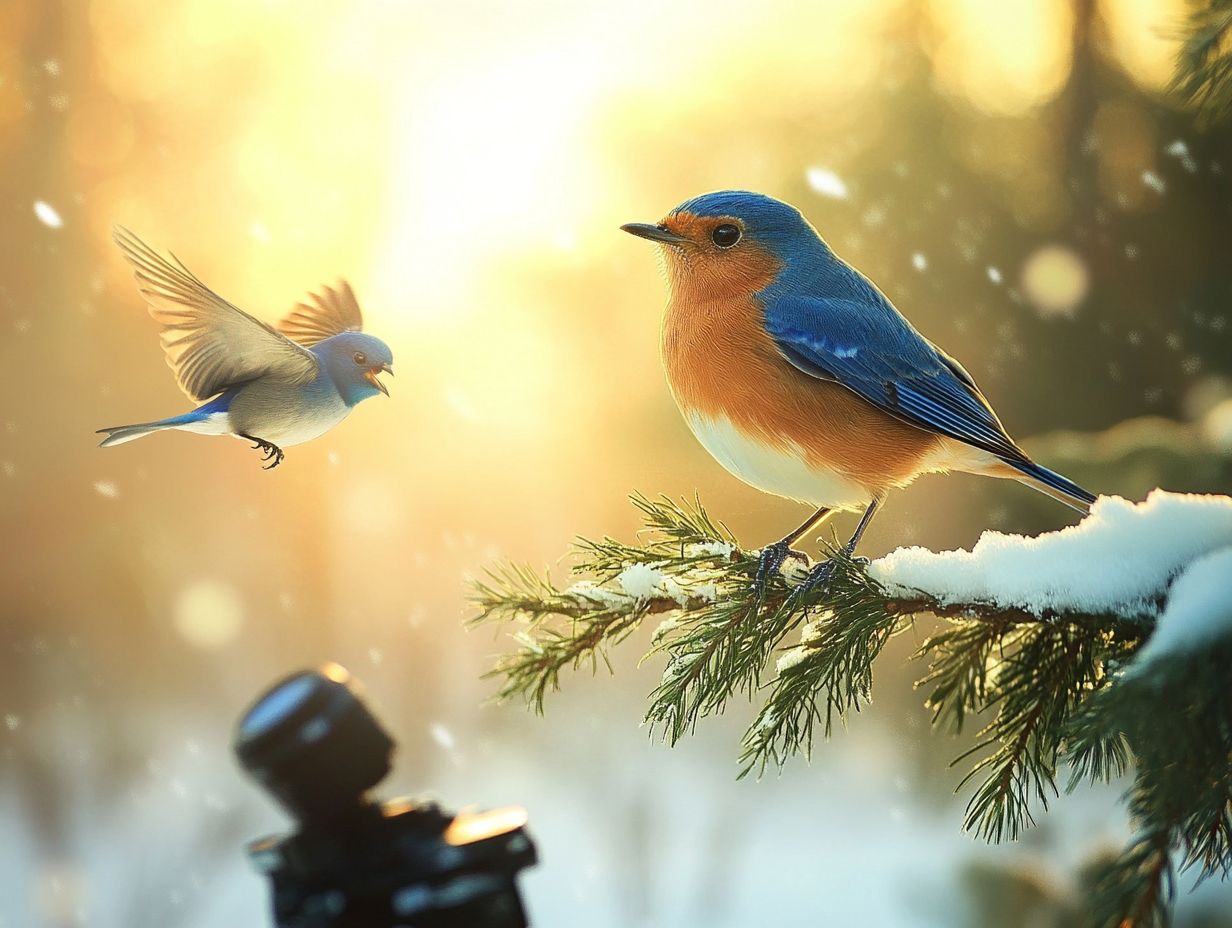
What are some tips for photographing birds in various settings?
1. Choose a location with varied settings: Look for places with a variety of environments, such as trees, bushes, and open areas. This will give you more options for capturing different backgrounds in your bird photographs. For more specific guidance, consider these tips for photographing rare bird species.
How can I use different settings to make my bird photos more interesting?
2. Use contrasting backgrounds: Try to utilize settings that contrast with the color of the bird. This will help the bird stand out and create a more visually appealing photo. For more tips, check out this guide on how to photograph migratory birds.
What camera settings should I use when photographing birds in various settings?
3. Adjust the opening in the lens: Use a wide opening (low F-stop number) to create a shallow depth of field, which will blur the background and make your bird subject stand out. For more tips, check out understanding exposure for bird photography and experiment with different settings to achieve the desired effect.
Is lighting important when photographing birds in various settings?
4. Watch the lighting closely: Good lighting is vital for all photography, especially in bird photography. Capture the perfect lighting to make your bird photos pop! Avoid harsh lighting or shadows that may distract from the bird.
How can I incorporate the natural habitat into my bird photos?
5. Use the surroundings to your advantage: Try to include elements from the bird’s natural habitat in your photos. This could be a tree branch or a nest, which will add depth and context to your images. To enhance your shots even further, consider how to use color theory in bird photography.
What are some compositional tips for photographing birds in various settings?
6. Apply the rule of thirds: When composing your shot, imagine dividing the frame into thirds both horizontally and vertically. Place your bird subject on one of the intersecting points for a balanced and visually appealing photo. This also complements other composition techniques you may use.
Now grab your camera and explore the beauty around you!

